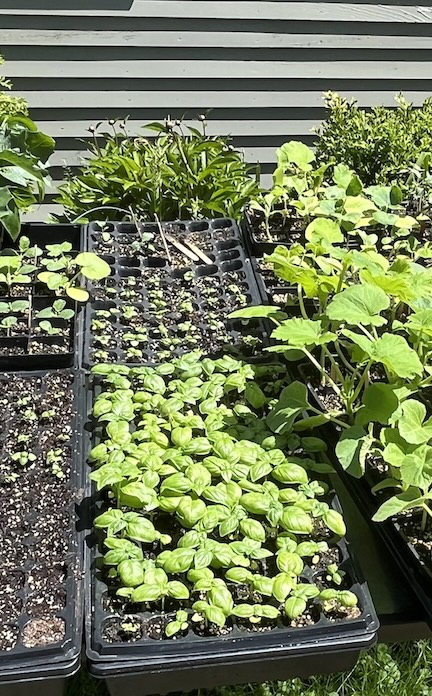By Jonathan Mitschele
I have grown basil for many years. It’s fragrance and taste mean summer is finally here! Two years ago, I happened upon a recipe for “Classic Marinara Sauce” that I have modified so that the flavor of basil is unmistakable. I have since ramped up my basil production accordingly so that I can make large batches of marinara sauce, which I freeze in two-serving quantities in plastic bags. Here is my recipe, adapted from The New York Times.
Marinara Sauce with Extra Genovese Basil
The batch yields 3½ cups of a sauce, which is enough for a pound of pasta. I use linguine.
28-ounce can of whole plum tomatoes
¼ cup olive oil
7 cloves of garlic, peeled and slivered, or pressed
1 tsp. salt
Basil, including leaves and stem, to taste
A note about the basil: My recipe calls for as many large sprigs of garden-fresh basil as it takes for the flavor of the herb to reach what you desire. When you first make this recipe, you can start conservatively and, if you think more basil is better, add more as you go — simmering the sauce long enough after each addition for the basil to infuse its delights — until you achieve the perfect balance of flavors. You will then have a good idea of how much basil to start with the next time.

To make the sauce, you first need to crush the tomatoes. You can either pour the canned tomatoes into a large bowl and crush them with your hands, or you can blitz them briefly in a food processor. (If you grow your own tomatoes, you can also adapt this recipe according to how you make your own fresh tomato sauce.)
Next, over medium heat, heat the olive oil in a large skillet (not cast iron, which reacts with acidity in tomatoes and could result in a metallic-tasting sauce). Add the slivered or pressed garlic.When the garlic begins crackling, but before it browns, add the tomatoes and salt, and stir.
Then immerse the basil, stem and all, into the tomatoes and oil. Simmer the sauce about 15 minutes, stirring as needed to prevent sticking. At this point, taste the sauce and add more basil if you want a stronger basil flavor; simmer an additional 15 minutes. When the sauce is done cooking, remove the basil.
Enjoy over pasta, or cool and freeze for later.
Growing Enough Basil for Your Sauce
I prefer to grow the variety Genovese, which I start from seed in 72-cell flats. After the threat of frost, I transplant the seedlings into blocks with 4-foot-long rows about 14 inches apart. Spacing for basil seedlings within each row is 1 foot between plants. I plant four per row — about 100 plants total. I mulch between the rows with grass clippings when the basil plants are 6 to 8 inches high; the mulch smothers weeds, provides some extra fertility, and keeps the soil moist. Pests have not been a real problem for me. However, Japanese beetles do like basil, but you can pick them off or, if you have lots of basil, ignore them.
Jonathan Mitschele taught chemistry and physics at Saint Joseph’s College in Standish for over 30 years. He began gardening in 1985, starting with one large garden but soon had three, growing corn, corn, corn, and onions, potatoes, winter squash, garlic, tomatoes, and salad greens.
This article originally appeared in the spring 2025 issue of The Maine Organic Farmer & Gardener.
